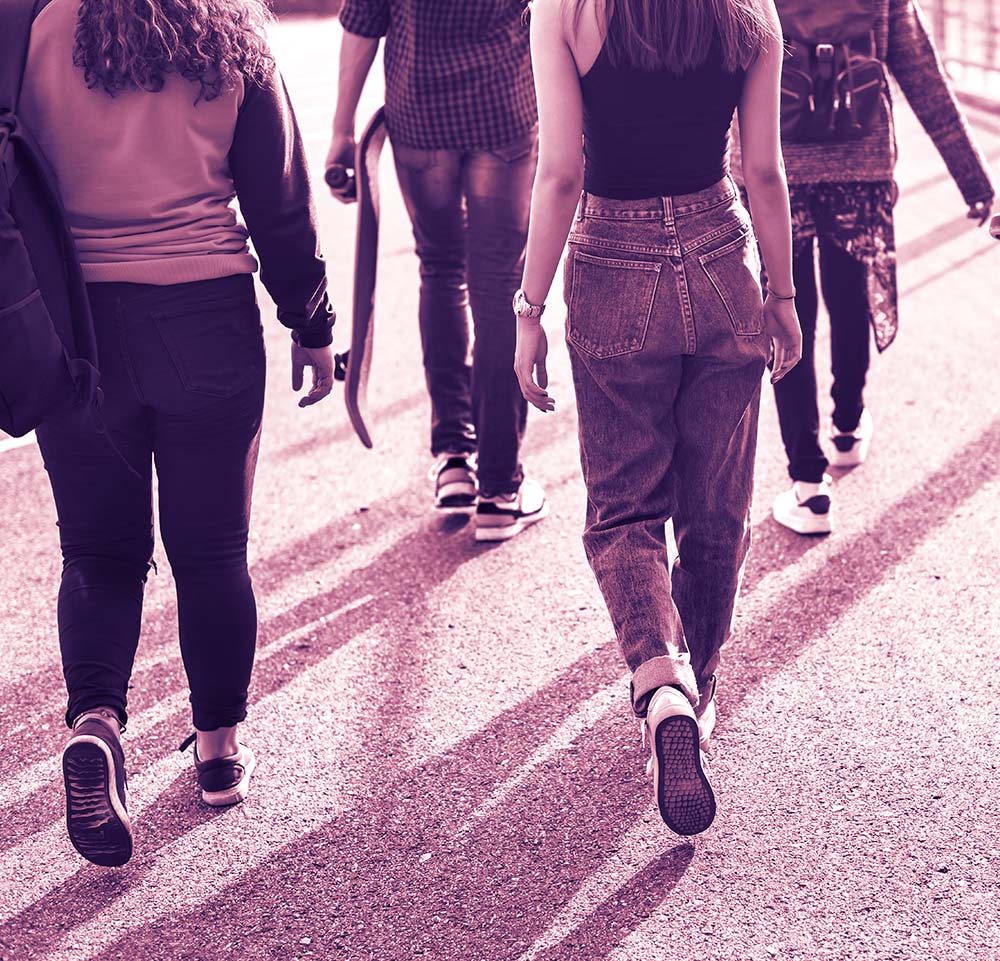Home

Justice
Home
esenia’s story is one of many that advocates and those who work with young people point to when discussing the necessity of moving away from punitive measures for adolescent crime and toward practices and interventions that promote healing, both for young people and their communities.
“I think people still maintain very black and white notions of who’s deserving of redemption or second chances. But something that we need to be considering is that, in many cases, when did they even get their first chance?” asked Renee Menart, communications and policy analyst for the Center on Juvenile and Criminal Justice. She explained that a young person dealing with a lack of basic necessities and exposure to trauma often also lack caring and supportive relationships. “When a young person does unfortunately come into contact with the justice system, [we can] give them an opportunity to connect with people in their community and to grow with some support.”
Menart and other youth advocates say when they call for changes to the youth justice system that move away from punishment and toward restoration, they are still pushing back against stereotypes such as the “super predator,” a young person — often depicted as Black or Latino — who is void of empathy and ready to go on a violent rampage. But the tides do seem to be turning.
As a requirement of Senate Bill 823, California began closing its three state-run youth detention centers in Fall 2021 and will gradually shift the responsibility of juvenile justice from the Department of Juvenile Justice (DJJ) to the state’s 58 counties. This means county offices of education, which administer and operate the juvenile court schools, are going to see students returning home.
Over the last several decades media reports and agency audits documented excessive force by correctional staff, substandard schooling and little support for mental health needs, in part fueling recidivism rates of up to 75 percent. In July, the state established the Office of Youth and Community Restoration (OYCR) under the Health and Human Services Department to support the realignment, provide oversight, evaluate and report on the efficacy of these county programs, and promote “trauma responsive, culturally informed services” for young people within the system. Beginning fiscal year 2022–23, counties must submit a plan to the OYCR describing “the facilities, programs, placements, services, supervision and re-entry strategies that are needed to provide appropriate rehabilitation and supervision services” in order to receive state funding.

“I think people still maintain very black and white notions of who’s deserving of redemption or second chances. But something that we need to be considering is that, in many cases, when did they even get their first chance?”
Renee Menart, communications and policy analyst for the Center on Juvenile and Criminal Justice
Nearly every child at some point does something dumb that they shouldn’t do or acts out in a crisis, he noted, “but in the past, if you were privileged, if you had options and support, if you weren’t targeted by law enforcement because of the color of your skin or the nature of your presentation, there are ways in which some young people had opportunities to recover from mistakes.”
For others, those mistakes took them down a path to systems like DJJ, Berrick said. “Now, what we’re doing is we’re setting up offramps, and we’re setting up different opportunities. Each of those opportunities for intervention is an opportunity point for a change in trajectory. That’s what’s so important and so very different.”
School Accountability Report Cards for each of the three DJJ-operated high schools for the 2019–20 academic year show stark disparities: 100 percent of youth across all three facilities are socioeconomically disadvantaged. Across the three facilities, Black youth make up between 22.3 and 34.5 percent of the incarcerated population and Latino or Hispanic youth make up between 51.7 and 66.7 percent; white youth make up between 4.2 and 8.9 percent of the student body enrolled in DJJ high schools.
Incarcerated youth often face the poorest academic outcomes. In 2018, just 8 percent of students at N.A. Chaderjian High School, 3 percent at Johanna Boss High School and 3 percent at Mary B. Perry High School scored proficient in reading, while no students at any campus scored proficient in math, according to the Unmet Promises report.
Staffing classrooms is among the current challenges — SARCs for the 2020–21 academic year show 36 teacher vacancies across the three high schools. Still, gains are being made, according to DJJ Director Heather Bowlds, Psy.D.
“Our goal is to support each youth so that they earn their high school diploma while they are with us,” she said in an email. “Youth whose commitment period is too short to fulfill the high school diploma requirements are given an opportunity to earn their GED. DJJ considers a diploma or GED a minimum requirement for parole consideration.”
Bowlds said DJJ held graduation ceremonies at each of their high schools in June, awarding 124 diplomas and 23 GEDs. As operations in DJJ facilities wind down, she said the department will work in “close collaboration with partners to ensure continued treatment and rehabilitation, programming and re-entry opportunities for youth offenders,” and that counties should establish local programming to meet the needs of all DJJ youth. According to Bowlds, 31.3 percent of its students have special education needs and 37.5 percent are English learners.
Due to sheer distance, it’s difficult, and in many instances impossible, to keep youth and their families together if the child is incarcerated. Families struggling with poverty and working multiple jobs can’t realistically travel over 100 miles away to visit their child every weekend, Menart said. Keeping youths within their county can provide more access for family.

- Provide and implement public health approaches to support positive youth development through long-term community-based approaches that can reduce crime
- Use evidence-based and promising practices and programs that improve the outcomes of youth and public safety
- Reduce the transfer of youth into the adult criminal justice system, allowing them to receive age-appropriate treatment and remain connected to their families and communities
In addition to the isolation from family, students in state facilities are often unfamiliar with the community resources they will need when they return home. “Being closer to home within their county is important because of the family piece, but also because a lot of transition services start while kids are incarcerated,” Morrill said. “Transition doesn’t start when they leave the facility — that planning and that contact with community-based organizations and private agencies happens from day one.”
In addition to distance, DJJ youth also deal with trauma even before their sentencing. A 2013 study from researchers at the National Center for Child Traumatic Stress, University of California, Los Angeles found up to 90 percent of justice-involved youth report exposure to some type of traumatic event. On average, 70 percent of youth meet criteria for a mental health disorder, with approximately 30 percent meeting criteria for post-traumatic stress disorder.
Some county offices of education are already working to address the needs of these students within their communities. In San Joaquin, Morrill said using restorative practices, trauma-informed care and Positive Behavior Interventions and Supports (PBIS) all together and ensuring all staff is trained in these three philosophies has been a major emphasis.
“You start it in the schools and students become well-versed and adept at having discussions and restoring strong relationships with each other, then that permeates out into the community. It reaches out to the homes,” Morrill said. “That’s been another emphasis, it’s really important to involve parents, family members and community members in restorative practices training so that you get a mix of perspectives in the room.”
“I think the thing that’s more important than just what the county office is doing is, what’s the county office doing in collaboration with our county mental health department, and with our county social services department? Because none of these systems can operate independently,” Berrick said, highlighting the importance of allowing youth to lead some of these discussions.
There are counties throughout the state already prioritizing this work. The Los Angeles County Board of Supervisors unanimously voted in November 2020 to dismantle the largest youth justice system in the nation in favor of a care-first model relying on agency and nonprofit collaboration, and emphasizing emotional support, counseling, education and treatment. Those arrested and convicted will be eligible to do their time in “Safe and Secure Healing Centers” located close to their neighborhoods and staffed by those trained in social work and youth development rather than law enforcement. They would also retain access to their local school and support system.
Margo Minecki, spokesperson for the Los Angeles County Office of Education, said in an email the COE “has maintained a direct focus on trauma-informed teaching and cultivating a culture of care throughout all our schools housed in secure care facilities.” Over the past few years, the county’s juvenile court schools have implemented the PBIS framework and increased counseling staff.
Currently, she said, all students in the county’s secure facilities receive a high-quality comprehensive education that provides a pathway for attaining a diploma and 21st-century skills. Still, with this statewide realignment, Minecki said that any support from state leaders to “improve career technical education classrooms would be very helpful, as we want to provide as many career pathways as possible to our long-term students. Additionally, we would like to provide more pathways to four-year universities, funding partnerships with major top-tier universities in the Los Angeles area and internship opportunities that lead to job attainment. Resources are critical to be able to financially support programs that best address our students’ needs.”
Those connections to institutions of higher education, trade schools and certification programs can help to reduce recidivism by allowing for smoother transitions back into society, San Joaquin’s Morrill said, noting it’s the successful transitions back into the community and into an educational or workforce setting that set the stage for justice-impacted youth to thrive. “An important part of success is that the kids and young adults don’t come back. When they don’t reoffend and don’t get locked up again, that’s the success,” he said.
Though the transition may be challenging, “it’s a beautiful way to examine your practices,” San Joaquin COE’s Kaeslin said. “And the silver lining of all of it is improved services for our youth in our community, and a stronger community because of it.”
The success of much of the work hinges on the ability to create buy-in among the community, which can be difficult when talking about ways of better supporting young offenders. Berrick spoke of an “endless rabbit hole of what ifs” when fielding questions of how to handle justice-impacted youth beyond traditional incarceration.
When something terrible happens, it’s hard to have the emotional resilience to look beyond it, he acknowledged, citing the importance of mitigating harm to the victims. “Even then, if we applied the standard of our own, as in, if it were my own child, or my own brother or sister, it’s pretty rare that we wouldn’t want to give people a second chance,” Berrick said. “The minute we start further objectifying an individual to be part of a population that is part of a problem, we’re off to the races.”
The best way to overcome that is to get to know the young people and the struggles they’ve faced, he explained. Intervening and providing support prior to a child acting out or committing a crime requires investment and engagement. “The earlier that you know that young person, the better your chances are to help impact them in a positive way,” Berrick said.
In recounting the first time she heard Yesenia tell her story at the San Joaquin COE years after first meeting her as a student, Kaeslin began to tear up. “I didn’t know her story and I didn’t bother — and I know better. Everything that I preach, and I didn’t ask her to tell me her story.” With the tension on campus between rival gangs reaching a boiling point, “I just needed her gone, and I got caught up in that rather than focusing on the student and that human that was in front of me,” Kaeslin said.
After hearing Yesenia’s story, Kaeslin worked with the COE administration and a local judge to get Yesenia a social security card and become a legal immigrant. Knowing that Yesenia had been the victim of a violent crime — one of the avenues toward gaining legal status — they worked with the Mexican consulate in Sacramento. Upon finding the Manteca police officer who took Yesenia’s statement as a child about the abuse she suffered had done something incorrectly, the judge and COE staff tracked down the officer and were able to prove that Yesenia was a victim of a violent crime and get her citizenship process moving.
Yesenia has since gotten married, bought a home, earned a master’s degree and has worked for several community nonprofits to help those whose experiences she understands, Kaeslin said. “Our charge is to develop a community of healing and belief in each one of our students, and that they feel it’s not just our words but our actions that help lift them.”
Alisha Kirby is a staff writer for California Schools.